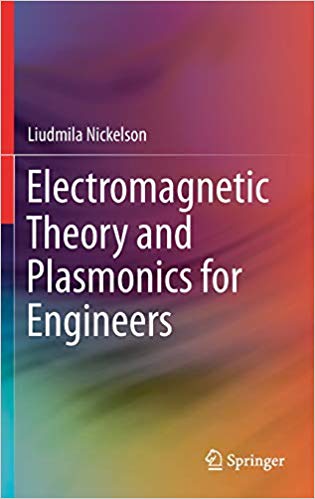The Centre of information technology and systems
About us
News
Professor Liudmila Nickelson: “Plasmonics as electromagnetic gate towards advanced technologies in the future”

2019-04-29
Professor Liudmila Nickelson: “Plasmonics as electromagnetic gate towards advanced technologies in the future”
One of today’s technologies with the fastest growth is plasmonics which is capable of ensuring a more rapid functioning of electronic elements. The field of plasmonics was analyzed by Prof. L. Nickelson from the Department of Electronic Systems of the Faculty of Electronics of Vilnius Gediminas Technical University (VGTU) alongside with her colleagues. Plasmonics and role thereof in the context of technologies is explored in the recently issued L. Nickelson's textbook “Electromagnetic Theory and Plasmonics for Engineers”.
Technology for Faster Devices
Plasmonics is a promising emerging technology which attempts to combine both photonic and electronic devices in order to achieve faster computation or communication systems, and create a brand new generation of biosensors, plasmonic chips functioning as ultra–low-loss optical interconnections, photovoltaic panels converting sunlight into electricity, etc.
For example, new plasmonic devices will facilitate the increasing speed of the Internet. In its most recent forecast network equipment manufacturer Cisco claims that the introduction of plasmonics will increase the Internet traffic to 3.3 trillion gigabytes each year from 2016 to 2021.
Role of Plasmonics in Technologies

Professor Nickelson notes that the most frequently used communications systems are either electronic or photonic devices. Scientists say that optical connections, such as fiber optic cables, can transmit digital data at more than 1,000 times greater power than electronic connections do.
“Fiber optic cables are approximately 1,000 times larger in comparison with electronic components, so it is difficult to combine these technologies into the same circuit. The interaction of light and metal surface has led to a new field of science – plasmonics, which effectively eliminates technical obstacles encountered today. Therefore, I will not be mistaken in saying that the plasmonics is like the electromagnetic gate to advanced technologies of our future,“ professor notes.
Bridge Connecting Technologies
Plasmons can be formed as a result of the incident of light on a conductive surface. These are collective oscillations of free electrons in a conductive environment, such as metal, where there is a high concentration of free electrons. In addition, plasmonics can be described as a bridge that connects electronic and photonic technologies.
Surface plasmons can be described as an electromagnetic wave propagating along the surface located on the metal and dielectric (air) boundaries. “For example, such two environments could be gold and air. The amplitude of a plasmonic wave gradually decreases with the increase of vertical distance from the surface. This means that the energy of the surface plasmons is the most concentrated in the area closer to the surface. It should be noted that the light consisting of photons (small portion of electromagnetic energy) is an electromagnetic wave capable of spreading even in a vacuum as it does not require any environment,“ professor L. Nickelson states.
She points out that the surface plasmon wave consists of the upper and lower parts separated by the boundaries of the two environments. “The upper part is the electromagnetic wave propagating in the air and the lower part consists of the electron plasma density wave formed by free electrons of the metal. Both parts of the plasmonic wave propagate at the same speed which may be lower than the speed of an electromagnetic wave inside a dielectric (air) environment,“ professor notes.
Moreover, the scientist pays attention to the fact that we could visualise the wave of surface plasmons to resemble a horse running through the shallow waters of a river. The lower part of the horse is in the water, thus causing concentric circles of water waves. The head of the moving horse creates an air swirl. The whole horse's body is in two environments at the same time. The horse, which we can compare with a plasmon wave, moves forward in the required direction as a whole body.
Technology for Faster Devices
Plasmonics is a promising emerging technology which attempts to combine both photonic and electronic devices in order to achieve faster computation or communication systems, and create a brand new generation of biosensors, plasmonic chips functioning as ultra–low-loss optical interconnections, photovoltaic panels converting sunlight into electricity, etc.
For example, new plasmonic devices will facilitate the increasing speed of the Internet. In its most recent forecast network equipment manufacturer Cisco claims that the introduction of plasmonics will increase the Internet traffic to 3.3 trillion gigabytes each year from 2016 to 2021.
Role of Plasmonics in Technologies

Professor Nickelson notes that the most frequently used communications systems are either electronic or photonic devices. Scientists say that optical connections, such as fiber optic cables, can transmit digital data at more than 1,000 times greater power than electronic connections do.
“Fiber optic cables are approximately 1,000 times larger in comparison with electronic components, so it is difficult to combine these technologies into the same circuit. The interaction of light and metal surface has led to a new field of science – plasmonics, which effectively eliminates technical obstacles encountered today. Therefore, I will not be mistaken in saying that the plasmonics is like the electromagnetic gate to advanced technologies of our future,“ professor notes.
Bridge Connecting Technologies
Plasmons can be formed as a result of the incident of light on a conductive surface. These are collective oscillations of free electrons in a conductive environment, such as metal, where there is a high concentration of free electrons. In addition, plasmonics can be described as a bridge that connects electronic and photonic technologies.
Surface plasmons can be described as an electromagnetic wave propagating along the surface located on the metal and dielectric (air) boundaries. “For example, such two environments could be gold and air. The amplitude of a plasmonic wave gradually decreases with the increase of vertical distance from the surface. This means that the energy of the surface plasmons is the most concentrated in the area closer to the surface. It should be noted that the light consisting of photons (small portion of electromagnetic energy) is an electromagnetic wave capable of spreading even in a vacuum as it does not require any environment,“ professor L. Nickelson states.
She points out that the surface plasmon wave consists of the upper and lower parts separated by the boundaries of the two environments. “The upper part is the electromagnetic wave propagating in the air and the lower part consists of the electron plasma density wave formed by free electrons of the metal. Both parts of the plasmonic wave propagate at the same speed which may be lower than the speed of an electromagnetic wave inside a dielectric (air) environment,“ professor notes.
Moreover, the scientist pays attention to the fact that we could visualise the wave of surface plasmons to resemble a horse running through the shallow waters of a river. The lower part of the horse is in the water, thus causing concentric circles of water waves. The head of the moving horse creates an air swirl. The whole horse's body is in two environments at the same time. The horse, which we can compare with a plasmon wave, moves forward in the required direction as a whole body.


